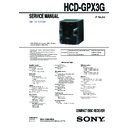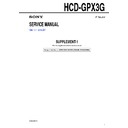Sony HCD-GPX3G Service Manual ▷ View online
SERVICE MANUAL
Sony Corporation
Published by Sony EMCS (Malaysia) PG Tec
HCD-GPX3G
9-890-598-05
2013C08-1
©
2013.03
E Model
Ver. 1.4 2013.03
• HCD-GPX3G is the amplifi er, USB, CD player
and tuner section in MHC-GPX3.
COMPACT DISC RECEIVER
CD Section
Model Name Using Similar Mechanism
HCD-EX66/EX88/EX99
Mechanism Type
CDM76B-D1BD76
Optical Pick-up Block Name
DA11MMVGP
SPECIFICATIONS
Amplifi er section
The following are measured at
Mexican model:
Mexican model:
AC 120 V – 240 V, 60 Hz
Other models:
AC 120 V – 240 V, 50/60 Hz
MHC-GPX3
Front speaker
Power Output (rated):
300 W + 300 W (at 4 ohms, 1 kHz,
1%
THD)
RMS output power (reference):
475 W + 475 W (per channel at
4 ohms, 1 kHz)
Inputs
TV/DVD/SAT (AUDIO IN) L/R
Voltage 1.2 V, impedance 47 kilohms
PC/GAME (AUDIO IN) L/R
Voltage 1.2 V, impedance 47 kilohms
(USB) port: Type A
USB section
Supported bit rate
MP3 (MPEG 1 Audio Layer-3):
32 kbps – 320 kbps, VBR
WMA: 48 kbps – 192 kbps
AAC: 48 kbps – 320 kbps
Sampling frequencies
MP3 (MPEG 1 Audio Layer-3):
32 kHz/44.1 kHz/48 kHz
WMA: 44.1 kHz
AAC: 44.1 kHz
Supported USB device
Mass Storage Class
Maximum current
500
500
mA
Disc player section
System
Compact disc and digital audio system
Laser Diode Properties
Emission Duration: Continuous
Laser Output*: Less than 44.6 μW
* This output is the value measurement
at a distance of 200 mm from the
objective lens surface on the Optical
Pick-up Block with 7 mm aperture.
Frequency response
20 Hz – 20 kHz
Signal-to-noise ratio
More than 90 dB
Dynamic range
More than 88 dB
Tuner section
FM stereo, FM/AM superheterodyne tuner
Antenna:
Antenna:
FM lead antenna
AM loop antenna
FM tuner section
Tuning range
87.5 MHz – 108.0 MHz (50 kHz step)
AM tuner section
Tuning range
Pan
Pan
American
models:
530 kHz – 1,710 kHz (10 kHz step)
531 kHz – 1,710 kHz (9 kHz step)
Other
models:
530 kHz – 1,610 kHz (10 kHz step)
531 kHz – 1,602 kHz (9 kHz step)
General
Power requirements
Mexican model: AC 120 V – 240 V, 60 Hz
Other models: AC 120 V – 240 V, 50/60 Hz
Power consumption
180
180
W
Dimensions (w/h/d) (excl. speakers)
(Approx.)
(Approx.)
280 mm × 335 mm × 440 mm
Mass (excl. speakers) (Approx.)
6.0
6.0
kg
Supplied accessories
Remote control (1)
R6 (Size AA) batteries (2)
FM lead/AM loop antenna (1)
Design and specifi cations are subject to
change without notice.
change without notice.
• “WALKMAN” and “WALKMAN” logo are registered trademarks of
Sony
Sony
Corporation.
• MPEG Layer-3 audio coding technology and patents licensed from
Fraunhofer IIS and Thomson.
• Windows Media is either a registered trademark or trademark of Microsoft
Corporation in the United States and/or other countries.
• This product contains technology subject to certain intellectual property
rights of Microsoft.
Use or distribution of this technology outside of this product is prohibited
without the appropriate license(s) from Microsoft.
Fraunhofer IIS and Thomson.
• Windows Media is either a registered trademark or trademark of Microsoft
Corporation in the United States and/or other countries.
• This product contains technology subject to certain intellectual property
rights of Microsoft.
Use or distribution of this technology outside of this product is prohibited
without the appropriate license(s) from Microsoft.
HCD-GPX3G
2
NOTES ON CHIP COMPONENT REPLACEMENT
•
•
Never reuse a disconnected chip component.
•
Notice that the minus side of a tantalum capacitor may be dam-
aged by heat.
aged by heat.
FLEXIBLE CIRCUIT BOARD REPAIRING
•
•
Keep the temperature of soldering iron around 270 °C during
repairing.
repairing.
•
Do not touch the soldering iron on the same conductor of the
circuit board (within 3 times).
circuit board (within 3 times).
•
Be careful not to apply force on the conductor when soldering
or unsoldering.
or unsoldering.
SAFETY-RELATED COMPONENT WARNING!
COMPONENTS IDENTIFIED BY MARK
0 OR DOTTED LINE
WITH MARK
0 ON THE SCHEMATIC DIAGRAMS AND IN
THE PARTS LIST ARE CRITICAL TO SAFE OPERATION.
REPLACE THESE COMPONENTS WITH SONY PARTS
REPLACE THESE COMPONENTS WITH SONY PARTS
WHOSE PART NUMBERS APPEAR AS SHOWN IN THIS
MANUAL OR IN SUPPLEMENTS PUBLISHED BY SONY.
MANUAL OR IN SUPPLEMENTS PUBLISHED BY SONY.
CAUTION
Use of controls or adjustments or performance of procedures
other than those specifi ed herein may result in hazardous radia-
tion exposure.
Use of controls or adjustments or performance of procedures
other than those specifi ed herein may result in hazardous radia-
tion exposure.
This appliance is classifi ed as
a CLASS 1 LASER product.
This marking is located on the
rear exterior.
a CLASS 1 LASER product.
This marking is located on the
rear exterior.
HCD-GPX3G
3
1.
SERVICING NOTES
............................................. 4
2. DISASSEMBLY
2-1. Side Case (L), Side Case (R) ......................................... 10
2-2. Top Panel Section ........................................................... 11
2-3. Front Panel Section ......................................................... 12
2-4. 2CH DAMP Board .......................................................... 12
2-5. Back Panel Section and Chassis ..................................... 13
2-6. CD Mechanism Deck ...................................................... 13
2-7. Base
2-2. Top Panel Section ........................................................... 11
2-3. Front Panel Section ......................................................... 12
2-4. 2CH DAMP Board .......................................................... 12
2-5. Back Panel Section and Chassis ..................................... 13
2-6. CD Mechanism Deck ...................................................... 13
2-7. Base
Unit
......................................................................... 14
2-8. Optical
Pick-up
............................................................... 14
3.
TEST MODE
............................................................ 15
4. ELECTRICAL
ADJUSTMENTS
........................ 17
5. DIAGRAMS
5-1. Block Diagram – CD/USB Section – ............................. 19
5-2. Block Diagram – MAIN Section – ................................. 20
5-3. Block Diagram – Display/Power Section – .................... 21
5-4. Printed Wiring Board – DISPLAY Board – .................... 23
5-5. Schematic Diagram – DISPLAY Board (1/2) – .............. 24
5-6. Schematic Diagram – DISPLAY Board (2/2) – .............. 25
5-7. Printed Wiring Board – BD76 Board – ........................... 26
5-8. Schematic Diagram – BD76 Board (1/2) – ..................... 27
5-9. Schematic Diagram – BD76 Board (2/2) – ..................... 28
5-10. Printed Wiring Board –
5-2. Block Diagram – MAIN Section – ................................. 20
5-3. Block Diagram – Display/Power Section – .................... 21
5-4. Printed Wiring Board – DISPLAY Board – .................... 23
5-5. Schematic Diagram – DISPLAY Board (1/2) – .............. 24
5-6. Schematic Diagram – DISPLAY Board (2/2) – .............. 25
5-7. Printed Wiring Board – BD76 Board – ........................... 26
5-8. Schematic Diagram – BD76 Board (1/2) – ..................... 27
5-9. Schematic Diagram – BD76 Board (2/2) – ..................... 28
5-10. Printed Wiring Board –
2CH DAMP Board (Component side) – ......................... 29
5-11. Printed Wiring Board –
2CH DAMP Board (Conductor side) – ........................... 30
5-12. Schematic Diagram – 2CH DAMP Board (1/2) – .......... 31
5-13. Schematic Diagram – 2CH DAMP Board (2/2) – .......... 32
5-14. Printed Wiring Board – VOLUME and USB Board – .... 33
5-15. Schematic Diagram – VOLUME and USB Board – ...... 34
5-16. Printed Wiring Board – TUNER1AM3R Board – .......... 35
5-17. Schematic Diagram – TUNER1AM3R Board – ............. 36
5-13. Schematic Diagram – 2CH DAMP Board (2/2) – .......... 32
5-14. Printed Wiring Board – VOLUME and USB Board – .... 33
5-15. Schematic Diagram – VOLUME and USB Board – ...... 34
5-16. Printed Wiring Board – TUNER1AM3R Board – .......... 35
5-17. Schematic Diagram – TUNER1AM3R Board – ............. 36
6.
EXPLODED VIEWS
6-1. Overall
Section
............................................................... 45
6-2. Front Panel Section ......................................................... 46
6-3. Top Panel Section ........................................................... 47
6-4. Back Panel Section ......................................................... 48
6-5. Chassis
6-3. Top Panel Section ........................................................... 47
6-4. Back Panel Section ......................................................... 48
6-5. Chassis
Section
............................................................... 49
7.
ELECTRICAL PARTS LIST
.............................. 50
TABLE OF CONTENTS
HCD-GPX3G
4
SECTION 1
SERVICING NOTES
UNLEADED SOLDER
Boards requiring use of unleaded solder are printed with the lead-
free mark (LF) indicating the solder contains no lead.
(Caution: Some printed circuit boards may not come printed with
Boards requiring use of unleaded solder are printed with the lead-
free mark (LF) indicating the solder contains no lead.
(Caution: Some printed circuit boards may not come printed with
the lead free mark due to their particular size)
: LEAD FREE MARK
Unleaded solder has the following characteristics.
• Unleaded solder melts at a temperature about 40 °C higher
• Unleaded solder melts at a temperature about 40 °C higher
than ordinary solder.
Ordinary soldering irons can be used but the iron tip has to be
applied to the solder joint for a slightly longer time.
applied to the solder joint for a slightly longer time.
Soldering irons using a temperature regulator should be set to
about 350 °C.
Caution: The printed pattern (copper foil) may peel away if
about 350 °C.
Caution: The printed pattern (copper foil) may peel away if
the heated tip is applied for too long, so be careful!
• Strong
viscosity
Unleaded solder is more viscous (sticky, less prone to fl ow)
than ordinary solder so use caution not to let solder bridges
occur such as on IC pins, etc.
than ordinary solder so use caution not to let solder bridges
occur such as on IC pins, etc.
•
Usable with ordinary solder
It is best to use only unleaded solder but unleaded solder may
also be added to ordinary solder.
also be added to ordinary solder.
NOTES ON HANDLING THE OPTICAL PICK-UP
BLOCK OR BASE UNIT
BLOCK OR BASE UNIT
The laser diode in the optical pick-up block may suffer electro-
static break-down because of the potential difference generated by
the charged electrostatic load, etc. on clothing and the human body.
During repair, pay attention to electrostatic break-down and also
use the procedure in the printed matter which is included in the
repair parts.
The fl exible board is easily damaged and should be handled with
care.
static break-down because of the potential difference generated by
the charged electrostatic load, etc. on clothing and the human body.
During repair, pay attention to electrostatic break-down and also
use the procedure in the printed matter which is included in the
repair parts.
The fl exible board is easily damaged and should be handled with
care.
NOTES ON LASER DIODE EMISSION CHECK
The laser beam on this model is concentrated so as to be focused
on the disc refl ective surface by the objective lens in the optical
pickup block. Therefore, when checking the laser diode emission,
observe from more than 30 cm away from the objective lens.
The laser beam on this model is concentrated so as to be focused
on the disc refl ective surface by the objective lens in the optical
pickup block. Therefore, when checking the laser diode emission,
observe from more than 30 cm away from the objective lens.
• Abbreviation
AR :
AR :
Argentina
model
E2
: 120V AC area in E model
E51
: Chilean and Peruvian models
MX
: Mexican model
Model
Part No.
HCD-GPX3G: E2, E51, AR
4-411-594-0[]
HCD-GPX3G: MX
4-411-594-1[]
MODEL IDENTIFICATION
– Model Number Lavel –
– Model Number Lavel –
RELEASING THE DISC TRAY LOCK
The disc tray lock function for the antitheft of an demonstration
disc in the store is equipped.
The disc tray lock function for the antitheft of an demonstration
disc in the store is equipped.
Releasing Procedure:
1. Press
1. Press
[I/
1
STANDBY] button to turn the power on.
2. Press the [CD/DISC SKIP] button to select CD function.
3. While pressing the [
3. While pressing the [
x
] button, press the [ENTER] button for
more 5 seconds).
4. The message “UNLOCKED” is displayed and the disc tray is
unlocked.
Note: When “LOCKED” is displayed, the slot lock is not released by
turning power on/off with the [?/1 STANDBY] button.
ANTENNA
FM/AM
AUDIO
IN
L
TV/
DVD/
SAT
PC/
GAME
FRONT SPEAKERS
R
L
IMPEDANCE
USE 4
R
Parts No.
Ver. 1.4
Note : Refer to SUPPLEMENT-1 for adding SERVICING
NOTES
NOTES
(TROUBLESHOOTING)


